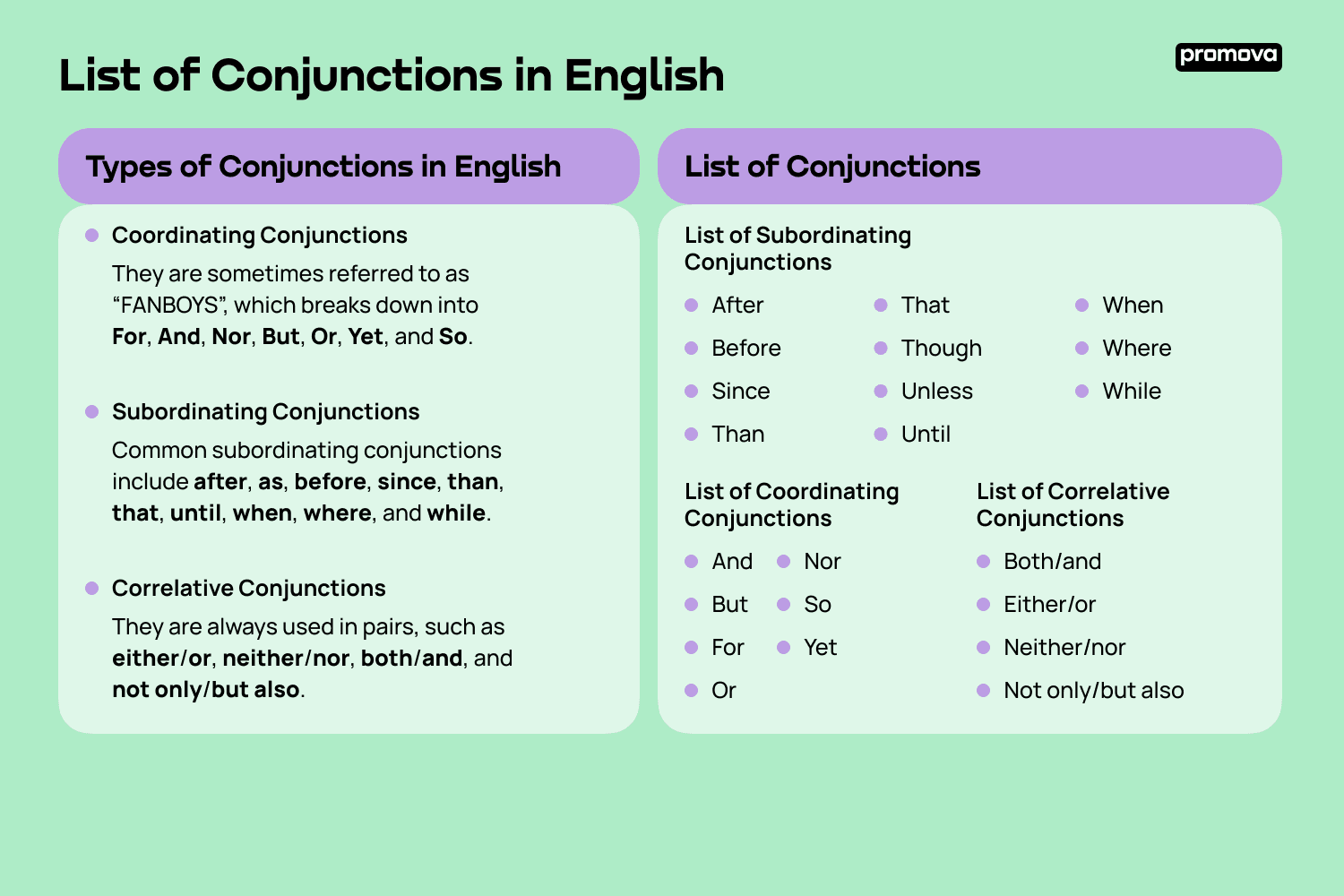List of Conjunctions in English
Contents
Conjunctions help us link two or more phrases, words, or clauses together. They are an important part of English grammar and understanding how to use them correctly is vital for learners. In this reference, we’ll take a look at the different types of conjunctions in English, provide a list, and offer examples of how to use them in sentences.
Types of Conjunctions in English
Conjunctions can be divided into three main categories: coordinating conjunctions, subordinating conjunctions, and correlative conjunctions. Let’s take a look at each type in greater detail.
Coordinating Conjunctions
Coordinating conjunctions help connect words, phrases, and clauses of equal importance. They are sometimes referred to as “FANBOYS”, which breaks down into For, And, Nor, But, Or, Yet, and So.
Subordinating Conjunctions
Subordinating conjunctions are used to connect two clauses or phrases together, where one is dependent on the other. Common subordinating conjunctions include after, as, before, since, than, that, until, when, where, and while.
Correlative Conjunctions
Correlative conjunctions are used to link two words, phrases, or clauses together. They are always used in pairs, such as either/or, neither/nor, both/and, and not only/but also.
List of Conjunctions
Now that you’ve got an idea of the different types of conjunctions in English, let’s take a look at a list of conjunctions.

List of Subordinating Conjunctions
- After
- Before
- Since
- Than
- That
- Though
- Unless
- Until
- When
- Where
- While
List of Coordinating Conjunctions
- And
- But
- For
- Or
- Nor
- So
- Yet
List of Correlative Conjunctions
- Both/and
- Either/or
- Neither/nor
- Not only/but also
7
Examples of Conjunctions in Sentences
It’s one thing to learn a list of conjunctions, but it’s another to use them in sentences. Let’s learn how to use conjunctions in sentences.
Subordinating Conjunctions
- After I finish my homework, I’ll go for a walk.
- Before we go out, we need to get changed.
- Since it’s raining, we can’t go to the park.
- That she didn’t come to the party was a surprise.
- Though it was dark, we went for a walk.
- Unless we leave now, we’ll be late.
- Until I hear from you, I won’t know what to do.
- When I get home, I’ll make dinner.
- Where she goes, I will follow.
- While we were at the beach, it started to rain.
Coordinating Conjunctions
- I went to the store, but I didn’t buy anything.
- I want to go outside, and I want to go for a walk.
- I can’t go to the party, or I have to study for my exam.
- He had a long day, so he went to bed early.
- I want to stay home, yet I have to go to work.
Correlative Conjunctions
- I want to go to the movies, but not only do I have to work, but I also have to study.
- I can either go to the party or stay home and study.
- Neither my parents nor my friends want to go to the beach.
- Both my parents and my friends want to go to the park.
List of Commonly Used Conjunctions
Now that you know the types of conjunctions in English and how to use them in sentences, let’s take a look at a list of commonly used conjunctions.
- And
- But
- For
- Or
- Nor
- So
- Yet
- After
- Before
- Since
- Than
- That
- Though
- Unless
- Until
- When
- Where
- While
- Both/and
- Either/or
- Neither/nor
- Not only/but also
Summary
Conjunctions can be tricky to understand and use, but they are essential to English grammar. There are three main categories of conjunctions: subordinating, coordinating, and correlative. Once you understand them, simply refer to this handy list to improve your vocabulary. Try doing some more conjunction practice exercises with Promova!
Comments